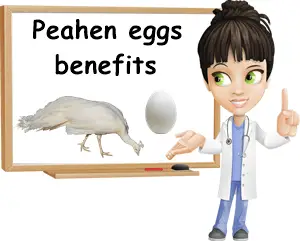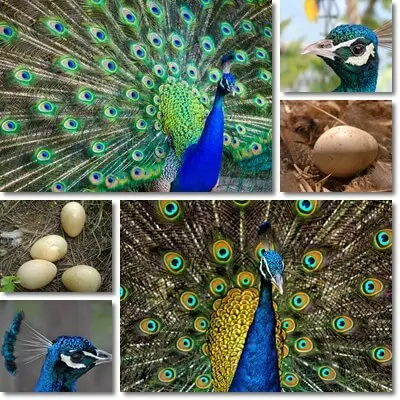Peahen eggs are the eggs of the female peafowl. Known for their extravagant, iridescent plumage with long trains of feathers looking like a fawn-shaped tail, peafowl are mostly kept for aesthetic purposes. The hens produce few eggs, usually 4 to 8 a year, just enough to hatch one small series of chicks. You can eat peahen eggs just like you would chicken, duck, quail, turkey, ostrich or virtually any other egg variety. Peahen eggs provide a similar nutrition to chicken eggs, the most notable differences being the slightly higher fat content of the egg yolk and higher yolk to egg white ratio, both of which mark minor changes in nutritional value and subsequent health benefits.
What do peafowl look like? Peafowl are related to pheasants and chicken, but look more like a hugely upgraded, adorned pheasant than the domestic chicken. The males are evocative of their species, with beautifully iridescent and rich plumage in metallic blue, green, bronze and gold hues, resonant, tuft-like head adornments or crests and a fan-shaped train of long feathers covering the tail and adorned with eyespots known as ocelli.

There are actually three types of peafowl species:
1) Blue peafowl or Indian peafowl (Pavo cristatus): the male has mostly iridescent blue plumage with imposing train and fan-shaped crest.
2) Green peafowl (Pavo muticus): males are iridescent green, gold and blue with brown and black feathers and long trains, upright. long crest.
3) Congo peafowl (Afropavo congensis): with a more contained spread of iridescent green, deep blue with violet tones on its back, the rest of the plumage black, shorter tail and white crown-like crest.
What do peahens look like?
The peahen is the female bird of the species and is usually less adorned, less colorful and less impressive in size than her counterpart. It lacks the long train of feathers covering the tail and sometimes the crest on the head. Peahen feathers do however retain some of the beautiful iridescent or metallic blue, green, gold, copper and bronze colors. Indian peahens have mostly dull, brown feathers with off white on the lower part of the abdomen, below the wings, iridescent green feathers on the neck and a crest, but no train. Green peahens have iridescent green and gold or copper feathers all over the neck and a little on the back and chest, giving the appearance of scales. The rest of the plumage is similar to that of the male bird, with less iridescence and green, bronze or brown plumage and a long, thin, upright crest. Like other peahens, the green peahen has no train. Lastly, the Congo peahen is a dull, chestnut brown and grey or black with metallic green back feathers or mostly brown plumage and a short crest, no train. All white or brown and white variations also exist.
What do peahen eggs look like?
Peahen eggs are larger than duck eggs (one duck egg weighs about 70 g), two or even three times the size of large domestic chicken eggs (estimated at 50 g an egg). The eggshell is thicker than that of chicken eggs and requires a bit more effort to break open. Peahen eggs are usually an off-white color. Slight variations in eggshell color may exist depending on the species and may range from a pale or light pink or yellow brown (buff color) to a grayish yellow-brown to moderate reddish brown (fawn color). The eggs also have a higher yolk to egg white ratio. Compared to chicken eggs, the yolk of peahen eggs is almost double the size and has a beautiful, deep golden yellow to orange color (reminiscent of free range chicken eggs). Are peahen eggs good to eat? Yes, peahen eggs are edible, safe to eat and about as nutritious as chicken eggs.

What do peahen eggs taste like?
Very similar to chicken eggs, actually. However, variations in taste have been noted, such as a richer-tasting egg yolk with faint sweet flavors or a gamy aftertaste. Some people remark the egg white is more bland-tasting than that of chicken (if it’s even possible for egg white to taste other than bland). Because of the higher yolk to egg white ratio, whole peahen eggs taste richer overall and will take longer to cook, especially in recipes such as sunny-side up eggs.
What are peahen eggs good for?
Despite little research being available, the most notable peahen eggs nutrition facts and health benefits are:
1) Rich source of protein. Like all eggs, peahen too provide important amounts of the highest quality protein, rich in all essential amino acids. Protein is satiating and helps build muscle mass and repair broken muscle fibers, also contributing to healthy weight loss. The amino acids that make up protein are further used to synthesize neurotransmitters for the brain that regulate mood, appetite, sleep and cognitive performance.
2) High in fat. Given the size of the yolk, peahen eggs are quite rich in fat, including saturated, unsaturated fatty acids and cholesterol. If consumed in moderate amounts, as part of a varied and balanced diet, the eggs make a great addition to any diet. The unsaturated fatty acids like Omega-3 promote brain and cardiovascular health. Cholesterol helps maintain the integrity of the myelin sheath surrounding the tail of nerve cells and offer a certain level of protection against degenerative diseases of the nervous system like multiple sclerosis. And the overall fat content of the eggs feeds the brain, helps sustain mental effort and reduces brain fog and mental fatigue.
3) Excellent B vitamins profile. All eggs are rich sources of B vitamins, peahen included. And the reason why they make a great addition to any diet is they provide important amounts of vitamin B12 in particular. Vitamin B12 together with cholesterol help make up the myelin coating that protects nerve cells and promote brain development in babies in the womb. Vitamin B12 further contributes to red blood cell production with direct effects on energy metabolism. Vitamin B9, also found in good amounts in peahen and other egg varieties, has been shown to prevent neural tube defects of the brain, spine and spinal cord in newborns as well as plays a major part in brain and nervous system development of babies in the womb. Other B vitamins in the eggs include: B1, B2, B3, B5 and B6.
4) Source of vitamin D and zinc for the immune system. Peahen eggs contain vitamin D naturally and provide good amounts of zinc as well. Both nutrients are vital for a strong immune system and overall good health.
5) Contain iron, phosphorus, magnesium, potassium and sodium. Peahen eggs contain important amounts of iron and help combat anemia and fatigue. The good amounts of phosphorus, magnesium and vitamin D boost bone health. Potassium, magnesium and sodium regulate blood pressure.
6) Source of selenium, iodine, calcium, chromium, copper, manganese, molybdenum. Found in trace amounts, these dietary minerals also contribute to the nutritional value of peahen eggs. Selenium and iodine are especially good for thyroid health, helping prevent hypothyroidism, while copper and manganese are important antioxidants.
7) Source of choline. Choline is a B vitamin-like nutrient known for its benefits for brain and nervous system activity. Eating eggs of all kinds can provide enough choline to support memory and prevent liver disease such as fatty liver disease. Choline is also good for pregnant women because it helps prevent neural tube defects of the brain, spine and spinal cord in newborn babies.
Peahen eggs vs chicken eggs
Both egg varieties have a similar appearance, nutritional properties and health benefits. But the difference in size, which accounts for different nutritional profiles, also generates different nutritional intakes. This is how the two egg varieties compare:
1) You’d get more protein from a whole peahen egg compared to a whole chicken egg (because it’s bigger and you basically eat more egg).
2) Because peafowls are better taken care of, they will also enjoy better diets most of the time and will produce eggs that are more like free-range chicken eggs. This means they are also likely to provide more healthy Omega-3 fatty acids (unless your chicken eggs are also free-range and on a very similar diet, in which case their Omega-3 levels would be very similar).
3) You’d get more fat, saturated, unsaturated and cholesterol, from 1 whole peahen egg or 1 peahen egg yolk than from 1 chicken egg or 1 chicken egg yolk (again, because the egg and yolk in particular are larger).
4) The more natural the birds diets (ideally, left to forage and requiring as little conventional feed as possible), the healthier the eggs. See full article on Peahen Eggs vs Chicken Eggs.
Also see other articles on the nutritional properties and health benefits of various egg varieties.
Frequently asked questions about peafowl
1) Can you eat peacock eggs? No, you can’t. The peacock is the male of the species and does not lay eggs. The peahen is the female of the species and does lay eggs. So you can eat peahen eggs.
2) How many eggs do peacocks lay? None. The peahens lay eggs. One peahen lays an average of 4-8 eggs a year, just to hatch chicks. In extraordinary conditions, a peahen may produce around 20 eggs a year, usually in spring.
3) What do peahens cost? A lot. Usually in the range of several hundred dollars, depending on age, species, plumage color and other factors. For example, fully white peahens may be extremely expensive as they are quite rare. Similarly, the more extensive the iridescent or metallic green or blue plumage of a peahen, the more it will cost.
4) Where can you get peahen eggs for incubation? If you have a peafowl pair, the peahen will lay the eggs and hatch them herself in 28 days. Alternatively, you can incubate the eggs yourself or simply buy peahen eggs for incubation from local farmers. If you get the young chicks (less than 6 months), you might not have a way to differentiate between the peahens and their counterpart.
